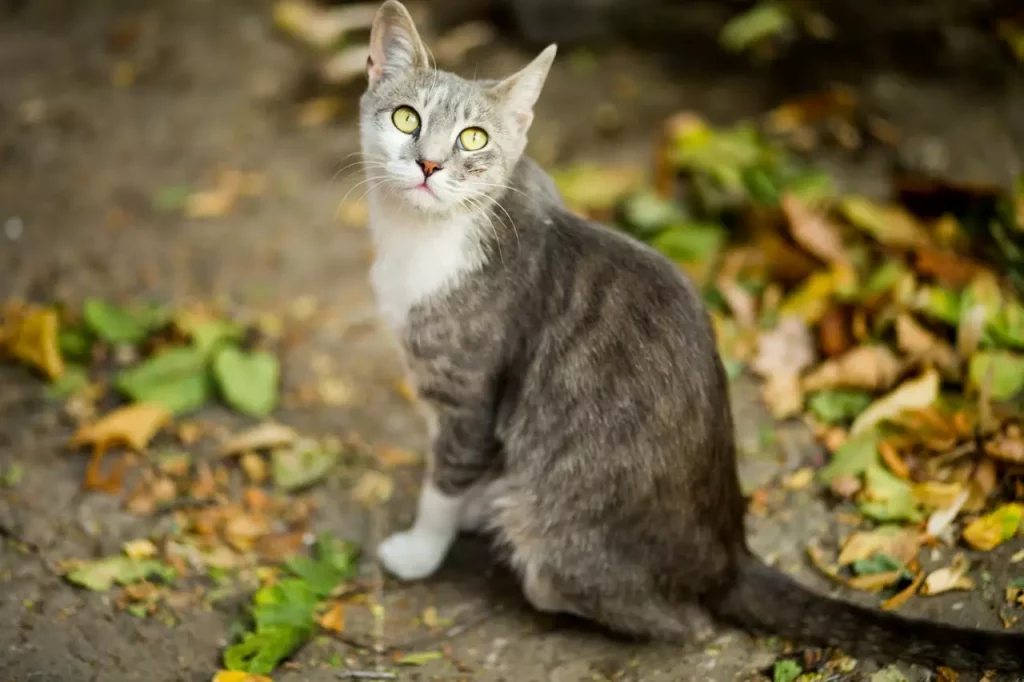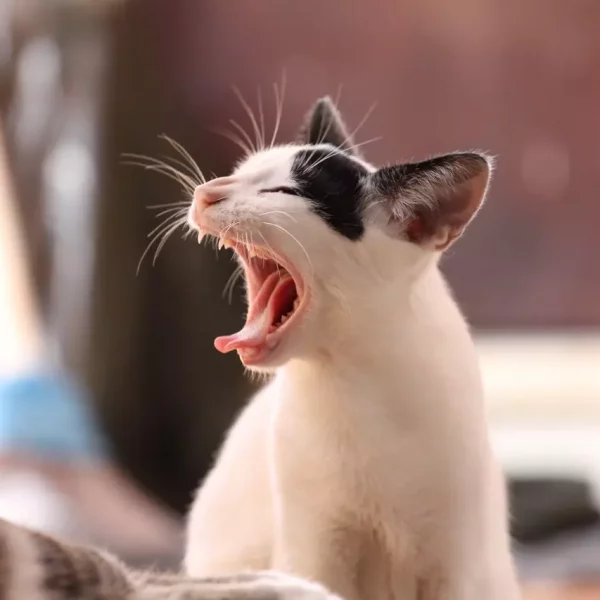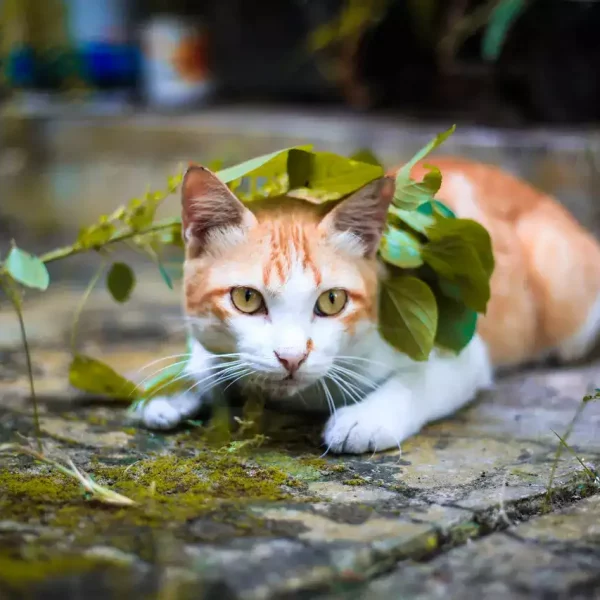With fall already setting in, the ground is already beginning to get covered by falling leaves, which are then swept up into large piles. Like any small child, cats cannot resist jumping into these large mounds of leafy goodness and rolling around in the ensuing carnage, but why do cats find leaves so irresistible to roll in?
Why do cats like jumping in leaves? It’s fun for cats to jump in leaves. Jumping into leaf piles and rolling around is massive fun for them. Cats also have a heightened sense of smell so the odor of rotting leaves is very strong for them, so they have to investigate.
However, while watching your cat barrel though the leaves can be a lot of fun, it is understandable to be worried about the potential dangers of things within these leaf piles. It can also be annoying to have to sweep up the leaves afterwards.
My own cat love to roll in leaves, but I did have other concerns too. For example, can cats be allergic to leaves? I decided to find out all there was about cats and leaves. Here’s what I found.
Why do cats love leaves?
The smell of autumn leaves is quite strong for humans and it can be very pleasant. Whilst humans only have around 5 million scent receptors, cats have over 220 million.
Just imagine what that might be like for a moment… with cats’ sense of smell being more than 40 times greater than ours, a pile of leaves is going to be a sensory overload.
Cats love leaves because of this smell and how leaves behave when rolled in. The smell of slowly rotting leaves, dirt and general smell of the outdoors can be an irresistible lure for cats. It will entice them want to go and investigate and then (in many cases) start rolling around.
Why do cats roll in leaves?
Cats also love to burrow. Digging is a natural instinct, and cats will cat for many reasons; smells, boredom, hiding, and mating instincts to name but a few.

Any cat owner will vouch for the fact that their cats love to roll in leaves. A giant pile of leaves that they can fully disappear into caters to that exact instinct. Not just that but throwing yourself headlong into a giant pile of leaves is just great fun.
We’ve all done it! Haven’t we?
I know I did when I was a kid, and cats are kind of like kids aren’t they? Well, ours certainly is and I love watching our cat roll in leaves.
How to keep your cat safe when jumping in leaves
Letting your cat jump in random piles of leaves when out for a walk may seem tempting, but there are some hidden dangers that could pose a risk to your cat’s health.
Piles of leaves may contain sharp sticks and branches that could cause major damage when landed on, as well as providing a hideaway for snakes or other critters which are far more active in the autumn and fall.
So, how do you make sure that your cat is safe when jumping in piles of leaves? Not only that, but there are also your kids to think about if you have children who may want to join in the fun.
1. Make your own leaf piles
Cat love leaves so making your own pile will eliminate any risk of sticks or other dangerous items that could be hiding inside the pile.
Make sure that the pile is away from any hard objects such as streetlamps, trees or benches that could cause injury if a jump goes too wide.
Freshly made leaf piles made at the time also means that snakes and other creatures do not have time to make a home in them before the pile is destroyed.
2. Supervise your cat
Keep an eye on your cat when they are out and about and jumping in leaf piles. You should make sure that they are safe and that you are present and able to step in if anything dangerous was to happen.
Another consideration is that if your cat really loves leaves, just a few jumps and rolls could put the wind up his tail. We find it can be quite hard to get our cat to chill out after he’s rolled in leaves, so you might need to temper this excitement after a while.
3. Check your cat for pests
Leaves are a popular home for ticks and other pests that could happily make their home in your cat’s fur.
As fall properly sets in, make sure that your cat is up to date on their shots and flea medication and, once you have finished with your leaf rolling and jumping, check your cat for any hitchhikers that could be making a home on your cat’s body.
Handy Hint: At the time of year leaves come down, it can also mean lots of acorns from oak trees. Did you know that acorns can be toxic to cats when eaten? Here’s what you need to be aware of.
How to stop your cat jumping in leaves
While watching a cat jumping and rolling in leaves can be cute, some cat owners do not want to take the chance and risk their cat’s safety. Other owners simply don’t want to have to keep on sweeping up leaves every day.
So, how do you stop your cat jumping in leaves?
Use the same kind of training technique as you may have used before to stop your cat exploring wayward smells when out during walks.
Initially, keep them on a short leash or a harness if they pull, and continue to walk past anything they want to investigate so they learn to keep pace with you and to ignore the leaf piles.
If you want to let your cat run around, let your cat off the leash in area without any leaf piles, such as areas where leaves haven’t been swept up yet.
However, cats are instinctively intrigued by interesting smelling things, so preventing them from interacting with leaves at all can be a bit cruel.
Allowing them to investigate leaves and small piles isn’t a bad thing, and you can even investigate them yourself before allowing your cat to dig his nose in and start rolling, just in case there is anything in there to cause damage.
Why do cats eat leaves?
Like grass, cats sometimes like to chew on and eat leaves. This can be puzzling to cat owners and, while there isn’t really a single explanation as to why they do it, they can eat leaves for a number of reasons.
They could be signalling a lack of fibre in their diet, be alleviating nausea or they could simply enjoy the sensation or taste of the leaf.

If you are worried about your cat chewing on leaves, speak to your vet who may be able to shed more light on why your cat particularly may be doing this.
In autumn and fall, fallen leaves are everywhere, meaning that your cat may be more likely to investigate and chew on leaves. This can be dangerous as some trees and other plants can be toxic to cats, such as the American Holly, Mandrake, American Bittersweet, Apple Trees, Bay Laurel and the Horse Chestnut.
For a full list of plants that are toxic to cats, visit the ASPCA’s information page on the subject.
Handy Hint: Find out whether it’s bad for your cat to eat moss and when it could be toxic or poisonous.
Related questions
If you have a cat who loves rolling in leaves and jumping in leaf piles you might still have some outstanding questions. Don’t worry, I’ve got you covered.
Is it OK for cats to eat dry leaves?
As mentioned above, some cats like to eat leaves and during the autumn and wintertime there are an awful lot more around on the ground for them to reach.
Cats like to investigate things, meaning putting things in their mouth as a way of testing it out and getting a better sense of taste and smell. Sometimes cats eat leaves to trigger nausea or to stop feeling sick, although it can also be a sign of a lack of nutrients in their diet.
But don’t worry if you spot your cat suddenly gain an interest in leaves, because sometimes cats just enjoy the taste.
If you are worried about your cat munching down on leaves more than usual, speak to your vet who will be able to identify if there is anything medically wrong that your cat is trying to let you know about.
What leaves are toxic to cats?
While most dry leaves lying around on the ground are safe for cats, there are certain plants and trees that you should watch out for.
While pine leaves cause severe vomiting and diarrhoea, other trees are far more dangerous, with fruit trees, oak, horse chestnut, yews, pine and macadamia nut trees causing everything from nausea and diarrhoea to convulsions and comas. They can also pose a risk to their kidneys.
If you believe your cat has ingested any of these tree leaves, seek medical help immediately and call the ASPCA Animal Poison Control Centre on 888-426-4435. If you live in the United Kingdom call your local vet.
How do I get my cat to stop eating leaves?
Some find it is better safe than sorry, especially if you live in an area with a lot of trees known to be poisonous for cats, and do not let their beloved cat eat leaves at all. But how do you go about it?
Any well-trained cat will already have experience with being told to leave something alone, often with a stern ‘no’ and having it taken away from them.
While sniffing at leaves is okay and expected for any inquisitive cat, as soon as they start to eat it pull them away with a gentle tug and carry on walking past.
Chewing on leaves can also be a sign of boredom or anxiety, so by giving your cat a new toy or by playing with them you can also distract them away from this as a nervous habit.
Can cats be allergic to leaves?
While certain leaves are toxic to cats, some cats are very prone to allergies that can cause reactions to many different types of leaves. A common allergy for cats to have is for pollen and while this allergy is more well known during the spring, they can start to act up again during the fall.
Symptoms can include the chewing or scratching at their fur, hair loss and other skin infections.
While these leaf allergies are more affected by the overall change of the season, decomposing leaves can be a trigger for mould and fungi to start growing, which cats can be allergic to.
With spores released into the air, your cat doesn’t have to necessarily eat a leaf in order for the allergic reaction to be triggered.
If your cat is known to suffer from leaf mould allergies, rake up any fallen leaves in your yard before allowing them to play outside. Then only take them for walks in areas where fewer leaves are, and rinse off their feet, legs and underside once returning home from woodland walks.
Handy Hint: If your cat’s urine is killing your grass, leaving nasty yellow dead patches, read this guide on why it happens and what you can do about it.
Conclusion
It’s a well-known fact that cats love jumping and rolling in leaves. It’s a part of their personality that is extremely endearing.
However, whilst you should never stop the fun that cats get from rolling in leaves, just exercise a little caution to make sure they don’t injure themselves.



Leave a Comment